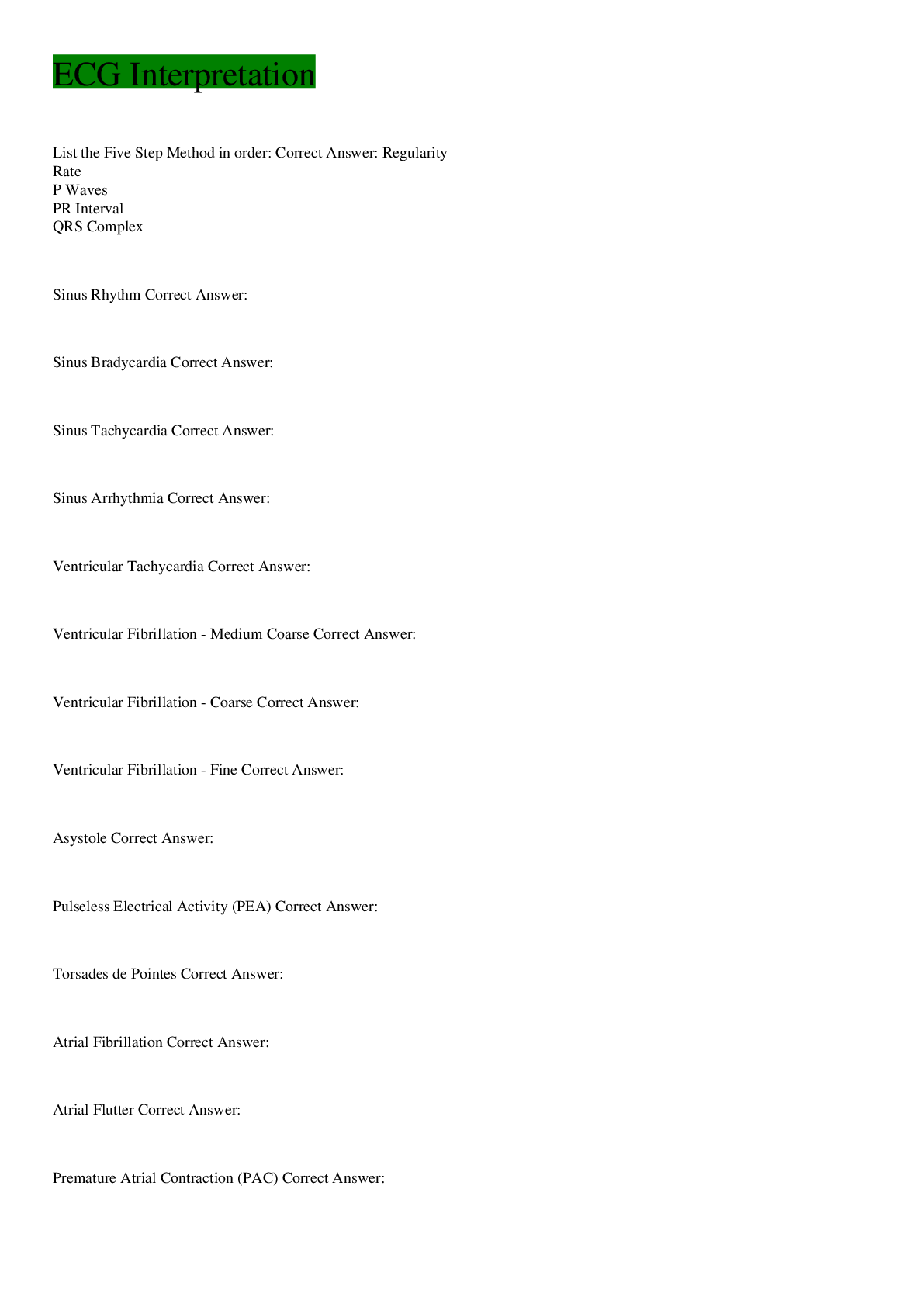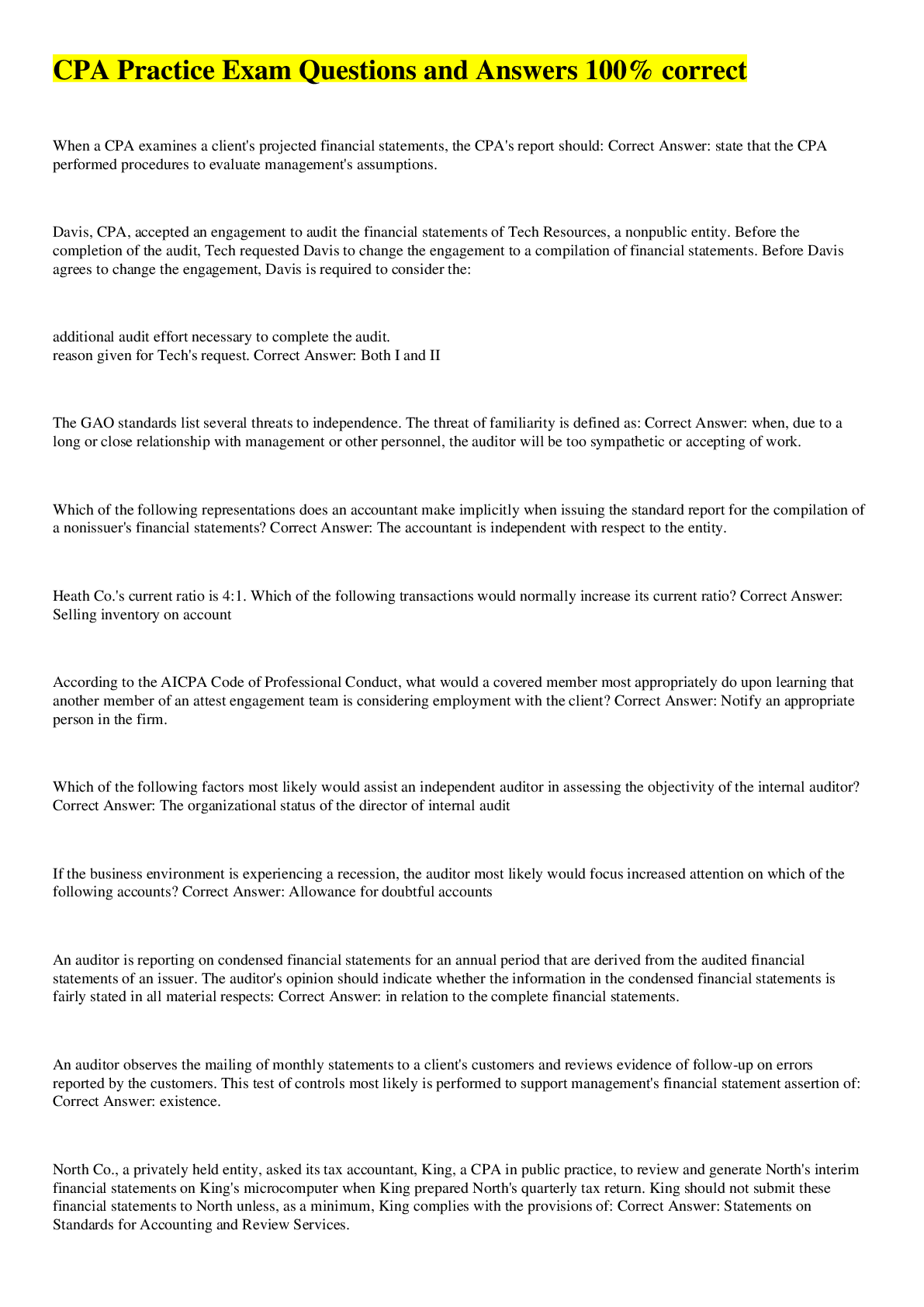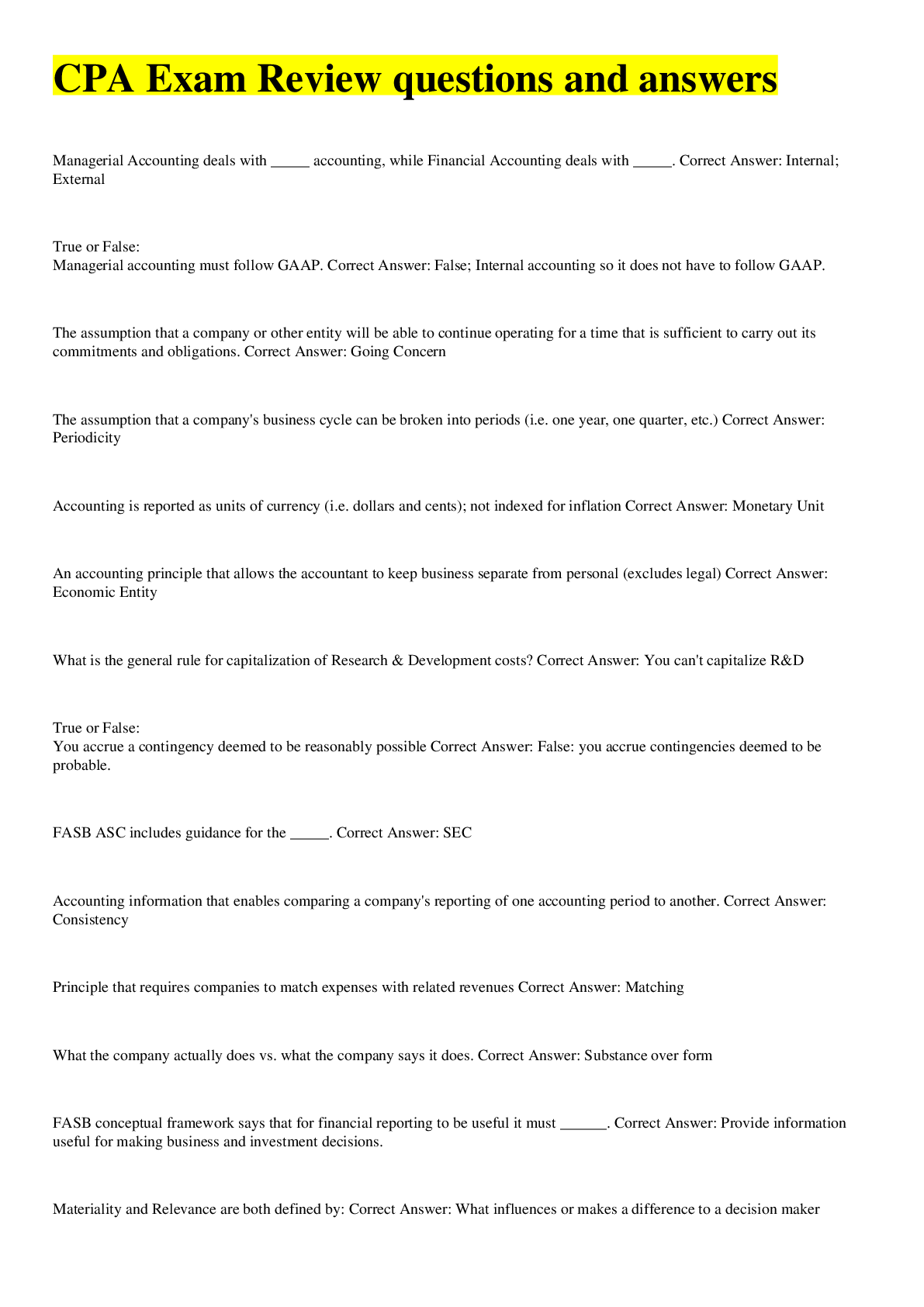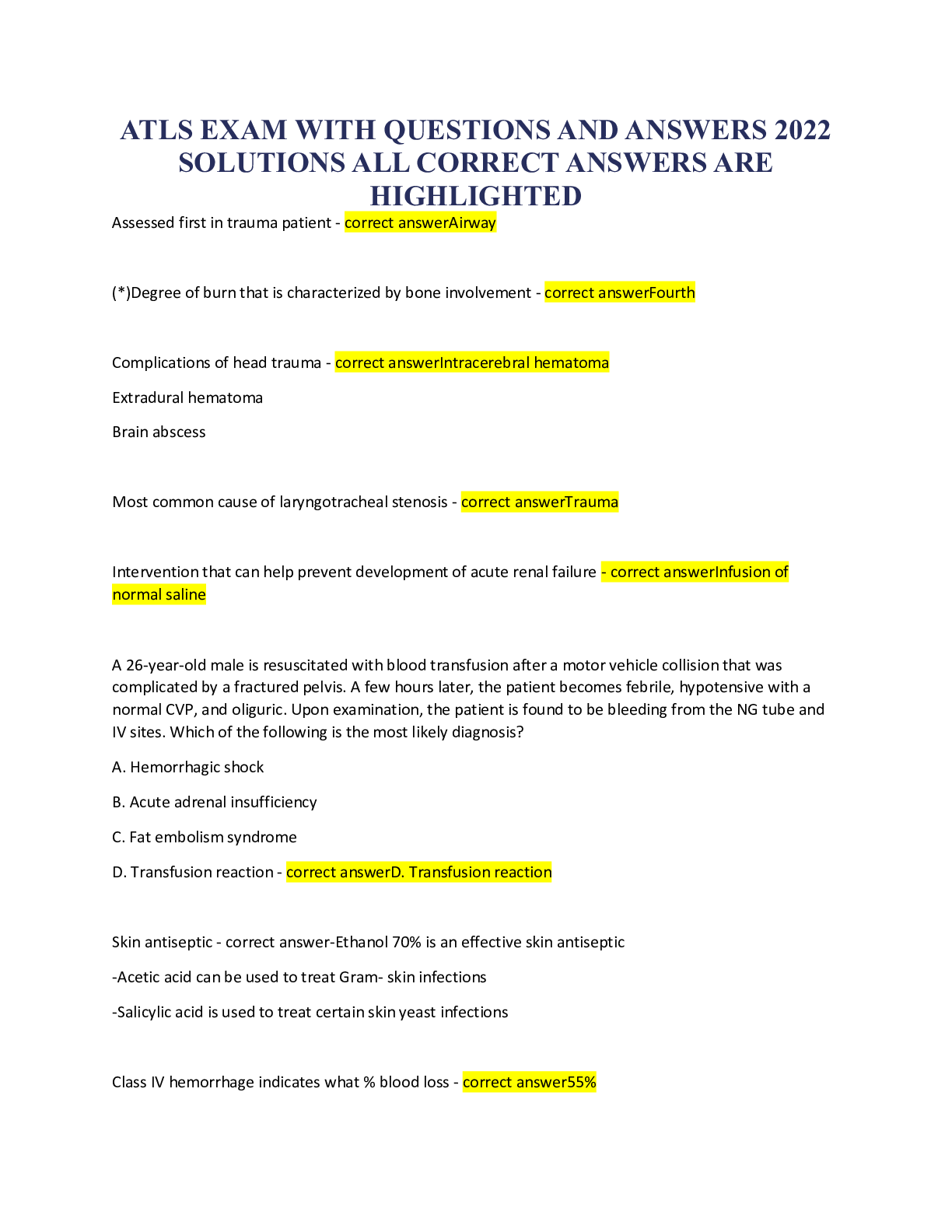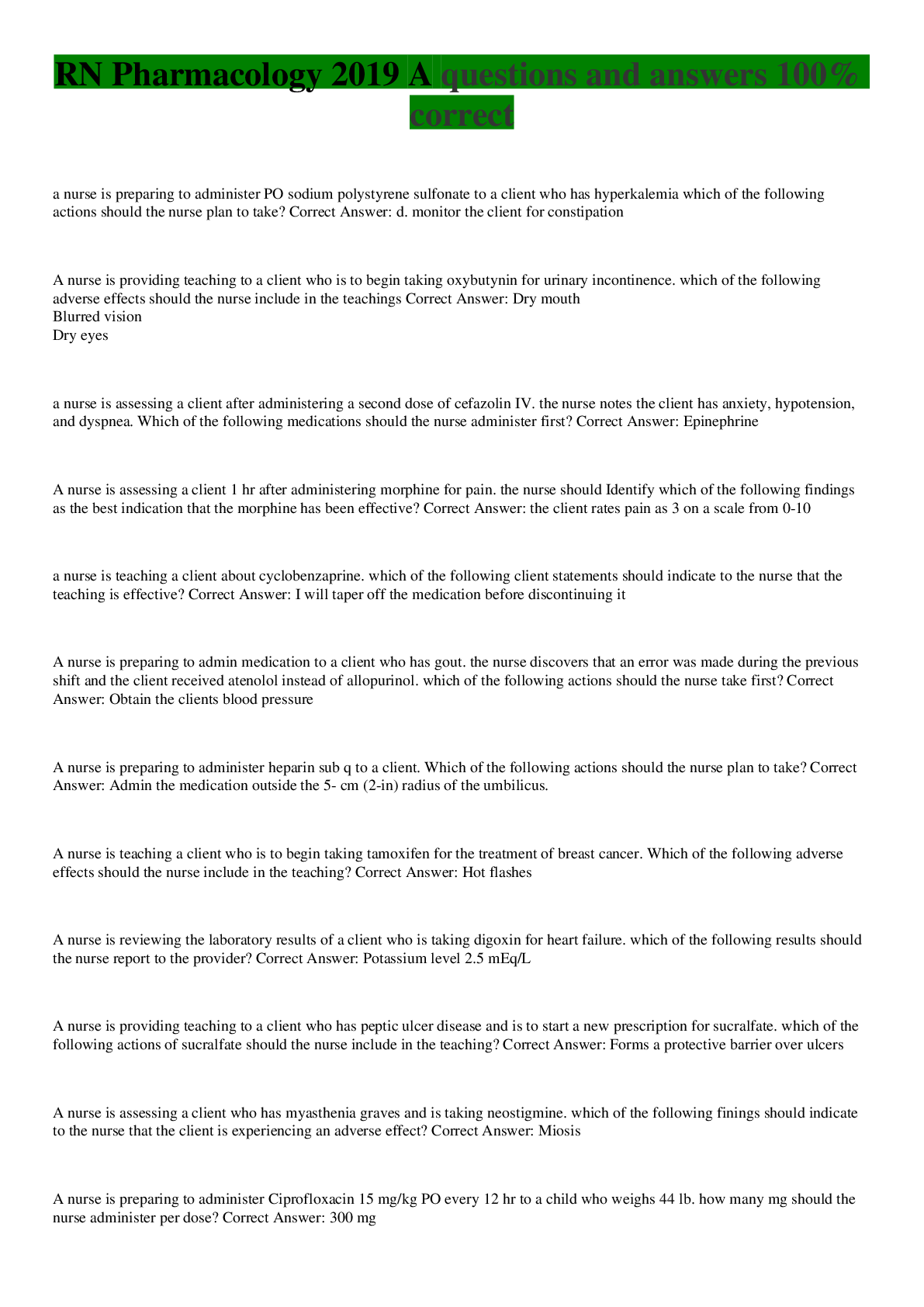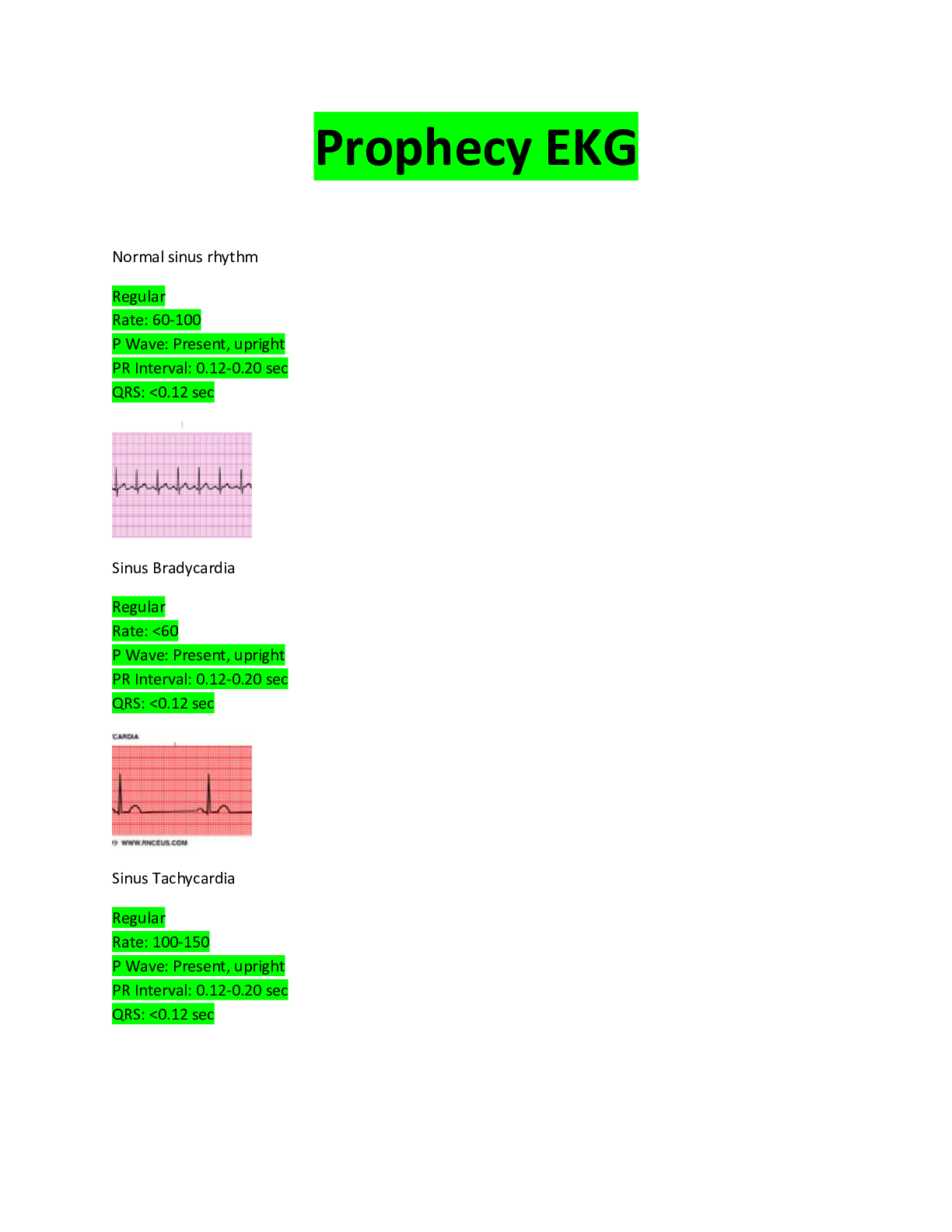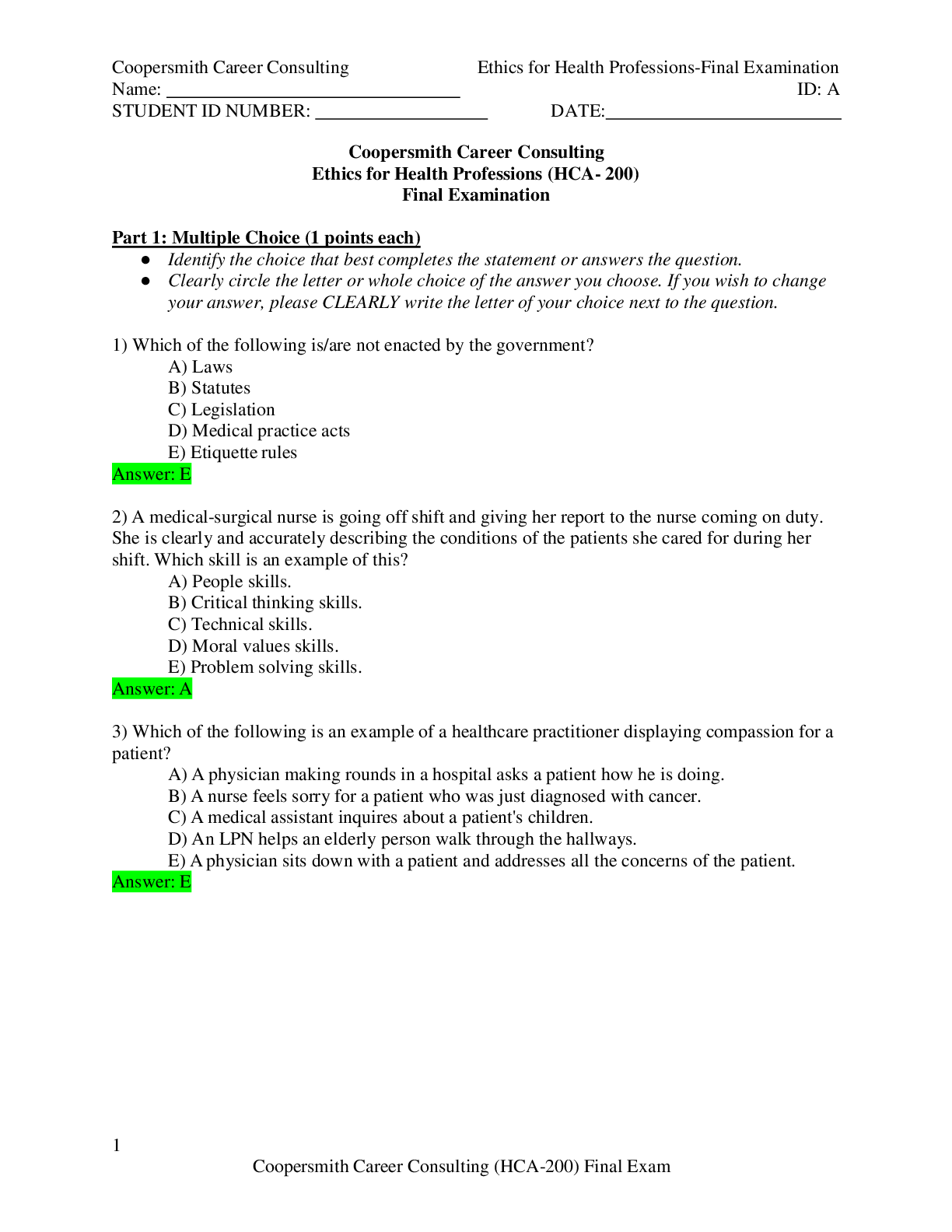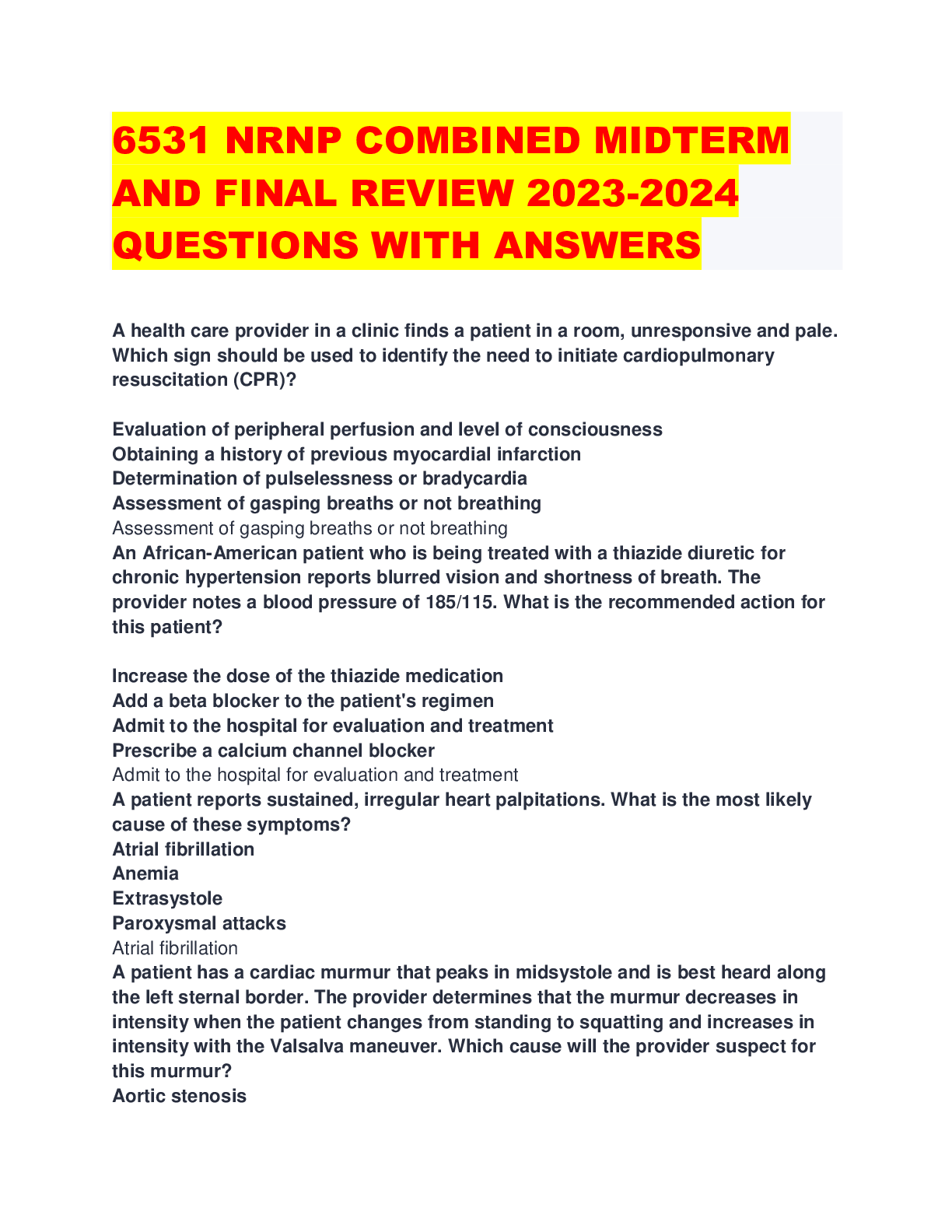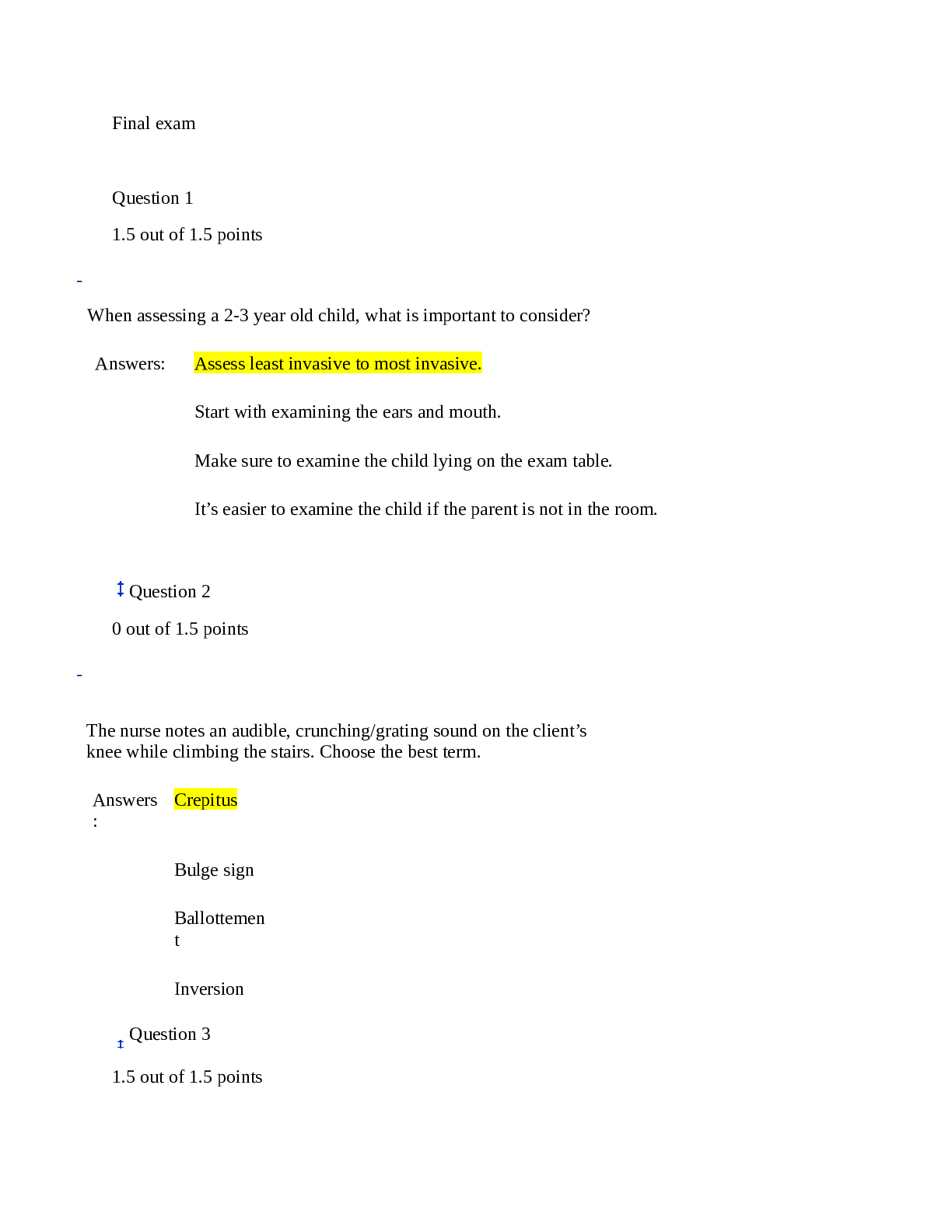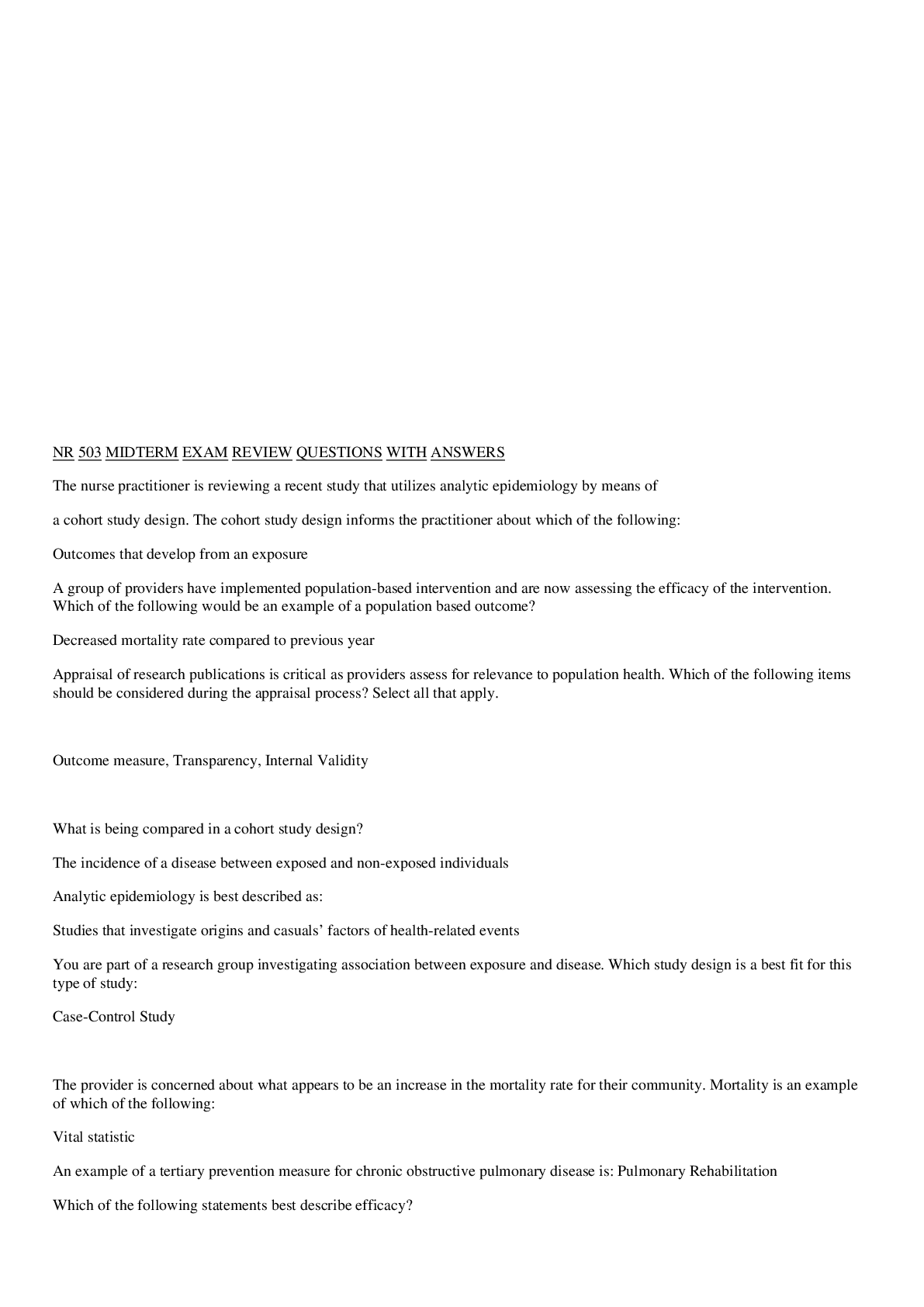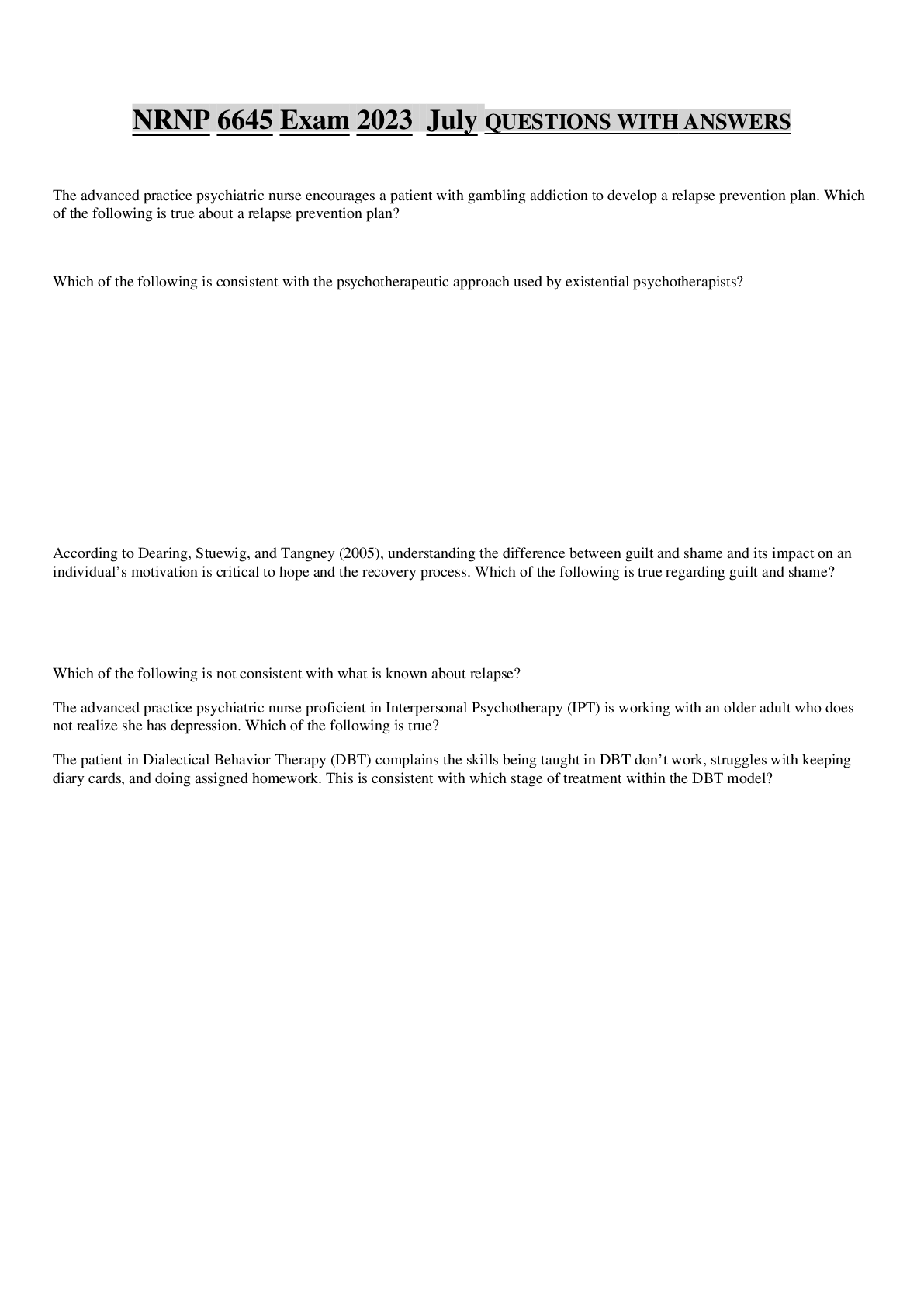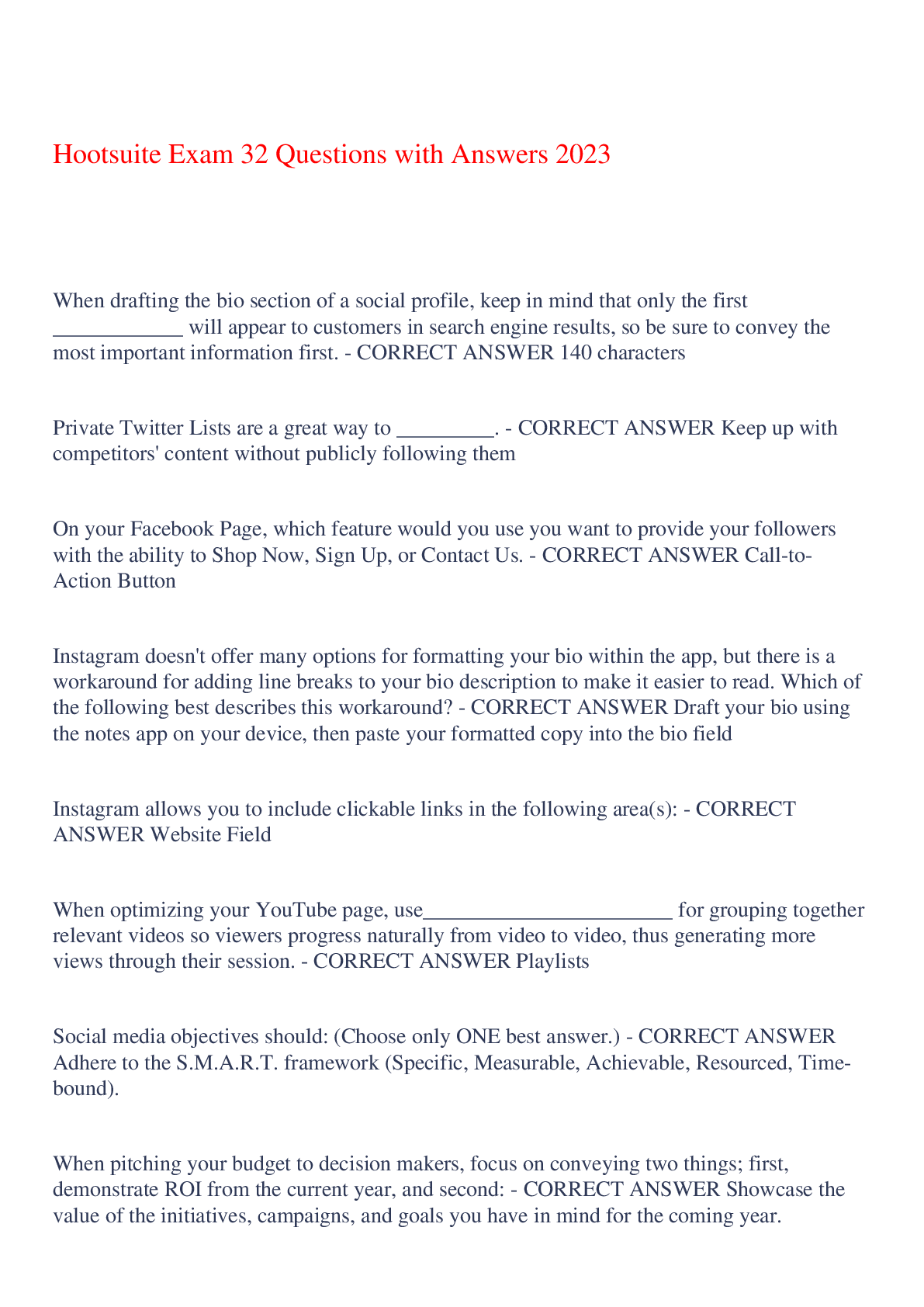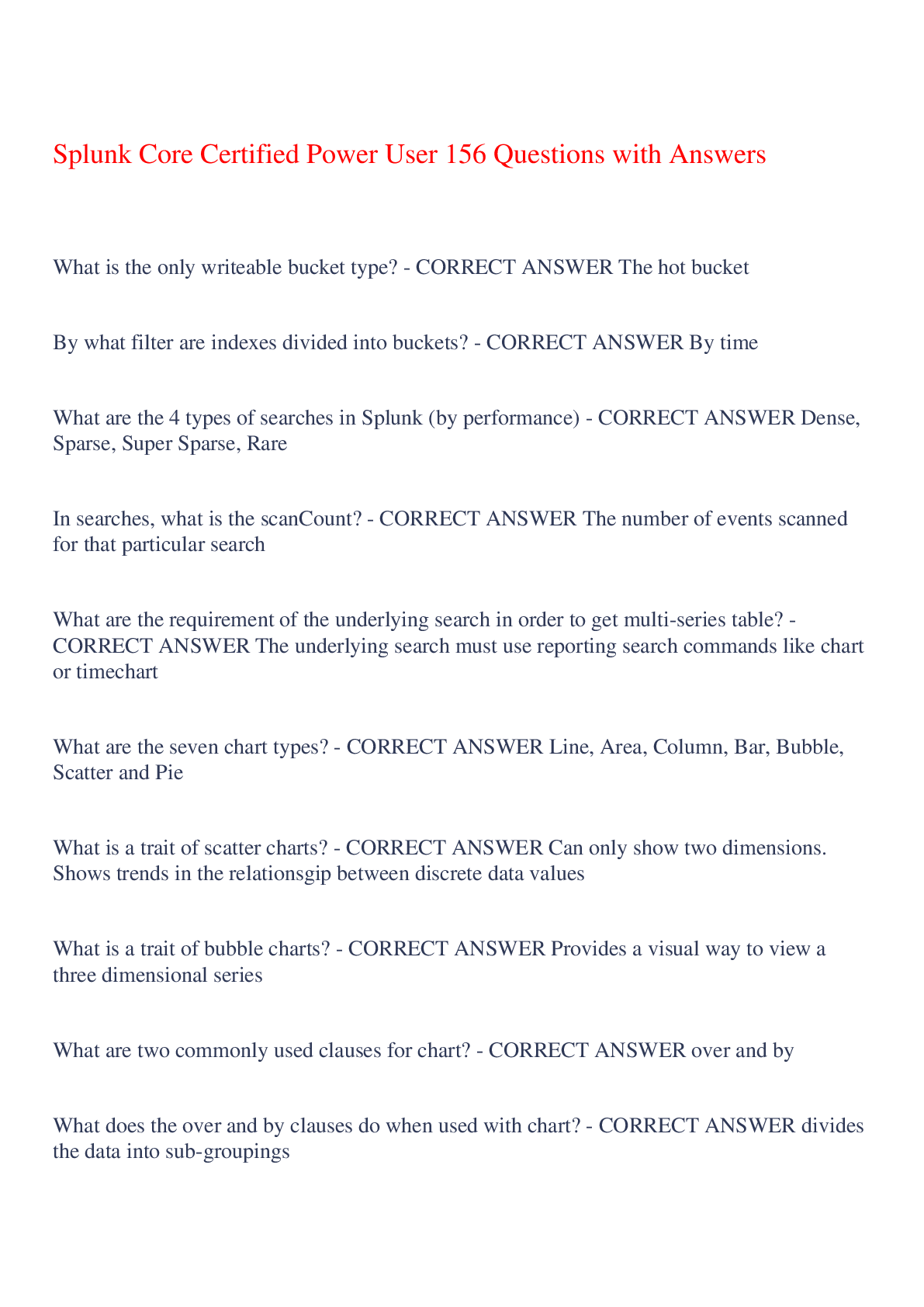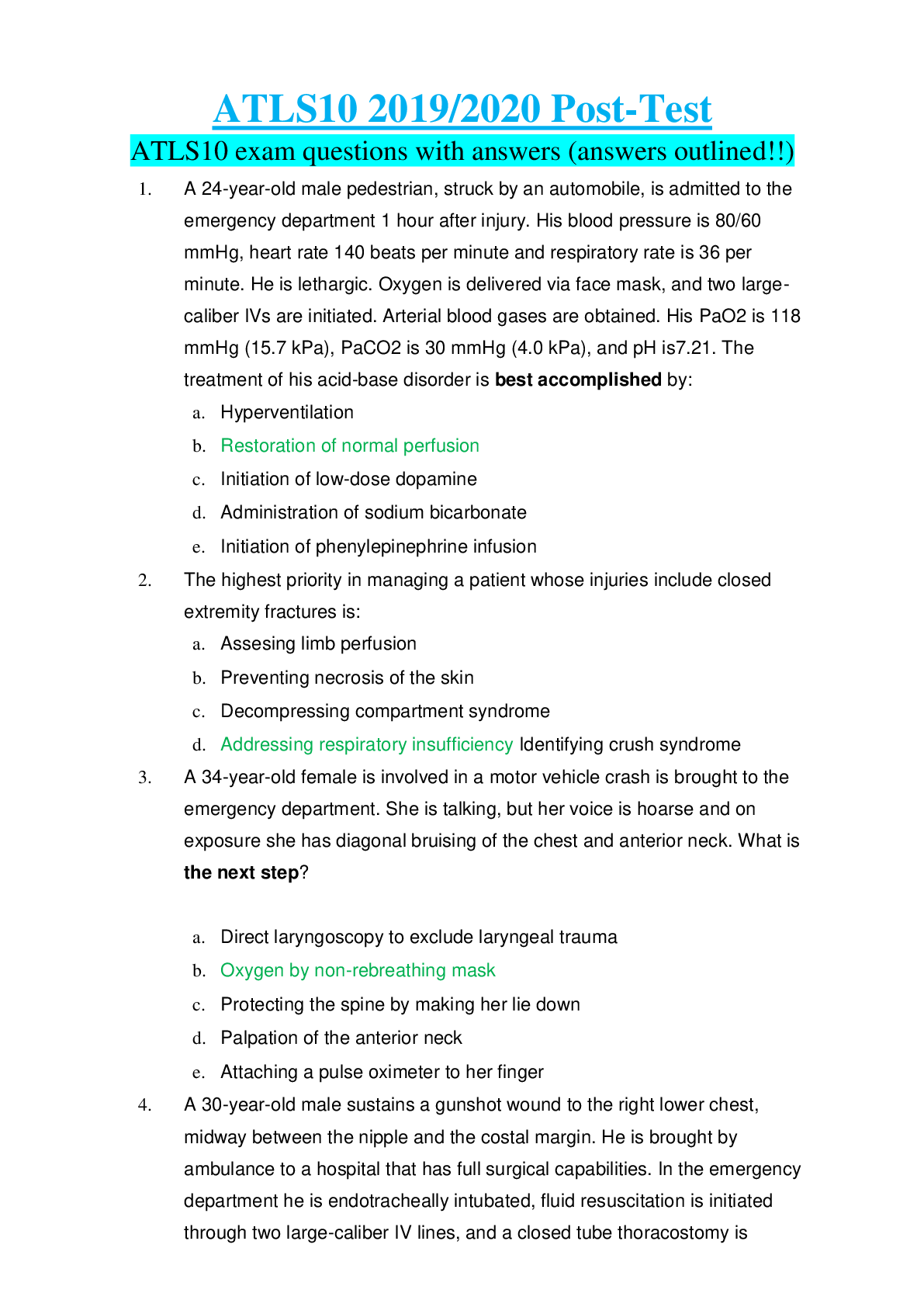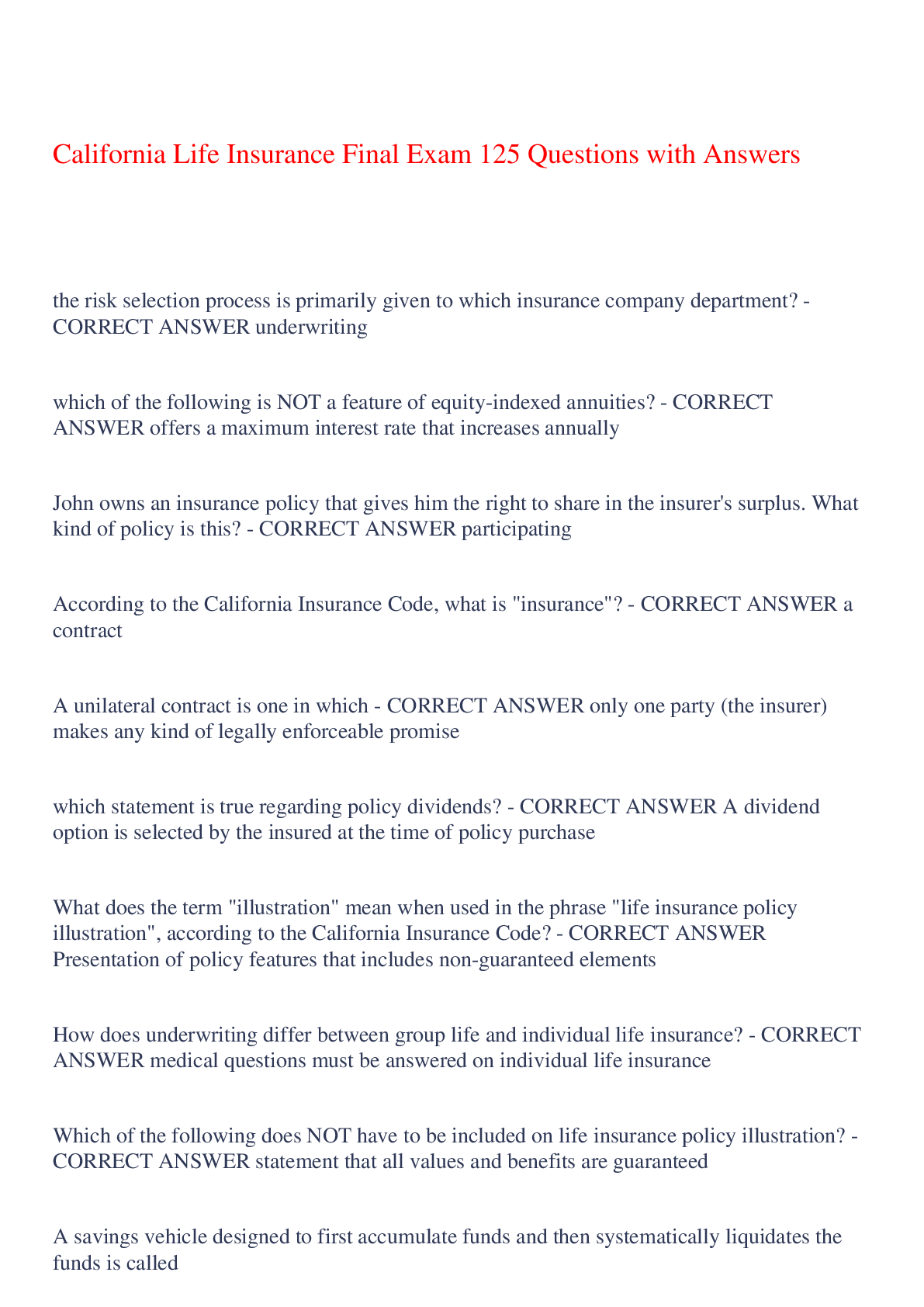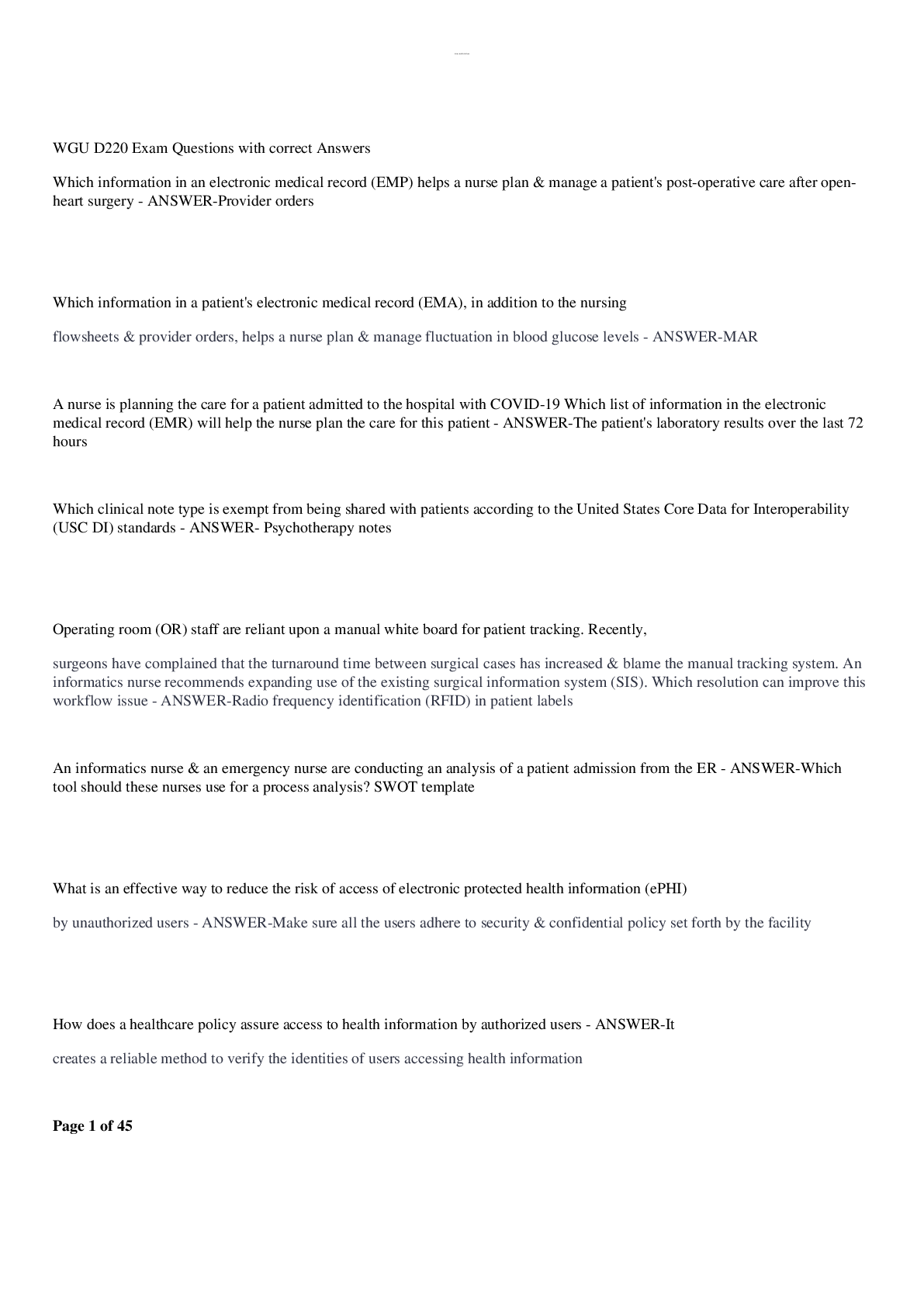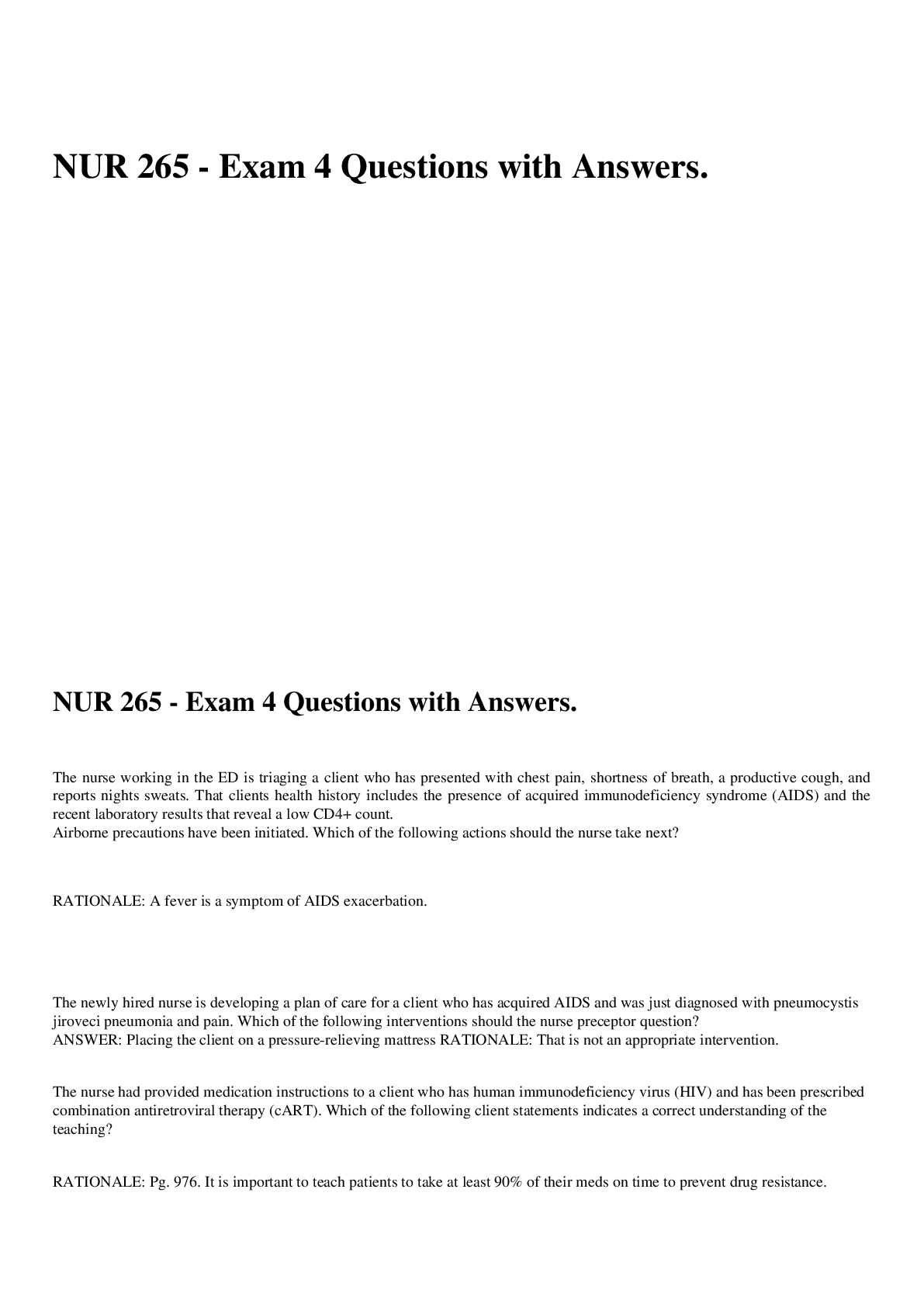Health Care > EXAM > Saunder's Comprehensive NCLEX Review Practice Questions with answers correct (All)
Saunder's Comprehensive NCLEX Review Practice Questions with answers correct
Document Content and Description Below
Saunder's Comprehensive NCLEX Review Practice Questions Which teaching method is most effective when providing instruction to members of special populations? 1. Teach-back 2. video instruction 3... . written materials 4. verbal explanation Correct Answer: 1. Teach-back Rationale: When providing education to members of special populations, return explanation and demonstration (teach-back) of are particular importance to ensure safety and mutual understanding. This method is the most reliable in confirming the client understands the instructions. Which health concerns should the nurse be aware of as risk factors when caring for clients of African American descent? Select all that apply: 1. cancer 2. obesity 3. hypertension 4. heart disease 5. hypothyroidism 6. diabetes mellitus Correct Answer: 1, 2, 3, 4, 6 Rationale: obesity, diabetes mellitus, hypertension, heart disease, asthma, and cancer are prevalent among African Americans. The nurse is planning care for a client of Native Hawaiian descent who recently had a baby. The nurse develops a teaching plan and includes info about which measure that's related to a newborn complication within this ethnic group? 1. safe sleeping 2. car seat safety 3. breast-feeding 4. baby-proofing Correct Answer: 1. Safe sleeping Rationale: The native Hawaiian population has a disproportionately higher rate of infant mortality compared with other ethnic groups. Sudden Infant Death Syndrome (SIDS) is a major cause of infant mortality. Safe sleeping is an important measure to prevent this newborn complication. The nurse is planning care for an assigned client. The nurse should include info in the plan of care about the prevention of HIV for which individuals specifically at risk? 1. lesbian persons 2. men-who-have-sex-with-men (MSM) 3. women-who-have-sex-with-women (WSW) 4. Female-To-Male (FTM) transgender persons Correct Answer: 2. MSM Rationale: MSM (men who have sex with men) are at a higher risk for HIV and AIDS. Which therapeutic communication technique is most helpful when working with transgender persons? 1. using open-ended questions 2. using their first name to address them 3. using pronouns associated with birth sex 4. anticipating the client's needs and making suggestions Correct Answer: 1. Using open-ended questions Rationale: The use of open-ended questions is the most helpful in communicating with transgender persons because it assists in refraining from judgment and allows the client the opportunity to express their thoughts and feelings. Which special population should be targeted for breast cancer screening by way of mammography? Select all that apply: 1. male-to-female (MTF) 2. female-to-male (FTM) 3. men-who-have-sex-with-men (MSM) 4. women-who-have-sex-with-men (WSM) 5. women-who-have-sex-with-women (WSW) Correct Answer: 1, 2, 4, 5 Rationale: Transgender persons who have undergone sexual reassignment surgery should have the respective preventive screenings. WSW and WSM should also have screenings. The nurse is volunteering with an outreach program to provide basic healthcare for homeless people. Which finding, if noted, should be addressed first? 1. BP 154/72 2. visual acuity of 20/200 in both eyes 3. random blood glucose level of 206 4. complaints of pain associated with numbness and tingling in both feet Correct Answer: 4. complaints of pain associated with numbness and tingling in both feet Rationale: With this population, the complaints of pain associated with numbness and tingling should be addressed first. If the client perceives value to the service provided, they will be likely to provide follow-up care. While the bp, blood glucose, and vision are concerning, the client's stated concern should be addressed first. The nurse is preparing discharge resources for a client being discharged to the homeless shelter. When looking at the discharge medication reconciliation form, the nurse determines there is a need for follow-up if which medication was prescribed? 1. Glipizide 2. Lisinopril 3. Metformin 4. Beclomethasone Correct Answer: 1. Glipizide Rationale: Glipizide is an oral hypoglycemic medication and is classified as a sulfonylurea. A major side effect of this medication is hypoglycemia, which is a safety risk to the homeless population. Lisinopril is an angiotensin-converting enzyme inhibitor. Although there are side effects that should be included in discharge instructions, there is less of a threat to safety with this medication and the benefits to it are important. Metformin is an oral biguanide and is used for type 2 diabetes mellitus. Hypoglycemia is less of a concern with this medication compared with other oral hypoglycemics. Beclomethasone is an inhaled corticosteroid used for obstructive lung disease, and although there are side effects the client should know about, there is not a particular safety risk associated with this medication for the homeless person. The nurse is completing the admission assessment for a client who is intellectually disabled. Which part of the client encounter may require more time to complete? 1. the history 2. the physical assessment 3. the nursing plan of care 4. the readmission risk assessment Correct Answer: 1. the history Rationale: intellectually disabled clients tend to be poor historians, and it may take more time to ask questions in different ways when collecting the history data. The nurse working in a correctional facility is caring for a new prisoner. The client asks about health risks associated with living in a prison. How should the nurse respond? 1. "health care is very limited in the prison setting" 2. "living in a prison isn't different than living at home" 3. "living in a prison can predispose a person to different health conditions" 4. "living in a prison is similar to living in a condominium complex or dorm" Correct Answer: 3. "living in a prison can predispose a person to different health conditions" Rationale: the environment of a prison can predispose a person to different health conditions. Option 1 does not address the client's question and options 2 and 4 convey incorrect information. A nurse working in a community outreach program for foster children plans care knowing that which health conditions are common in this population? Select all that apply: 1. asthma 2. claustrophobia 3. sleep problems 4. bipolar disorder 5. aggressive behavior 6. ADHD Correct Answer: 3, 4, 5, 6 Rationale: foster children are at risk for a variety of health conditions later in life, including ADHD, aggressive behavior, anxiety disorder, bipolar disorder, depression, mood disorder, PTSD, reactive detachment disorder, sleep problems, prenatal drug and alcohol exposure, and personality disorder. Claustrophobia and asthma are not specifically associated with foster children. The nurse is caring for a female client in the ED who presents with a complaint of fatigue and SOB. Which physical assessment findings, if noted by the nurse, warrant a need for follow up? 1. reddened sclera of the eyes 2. dry flaking noted on the scalp 3. a reddish-purple mark on the neck 4. a scaly rash noted on the elbows and knees Correct Answer: 3. a reddish-purple mark on the neck Rationale: The client should be screened for abuse. Battered women experience bruises, particularly around the eyes, red or purple marks on the neck, sprained or broken wrists, chronic fatigue, SOB, muscle tension, involuntary shaking, changes in eating and sleeping, sexual dysfunction, and fertility issues. Mental health issues can also arise including PTSD, nightmares, anxiety, uncontrollable thoughts, depression, anxiety, low self-esteem, and alcohol and drug abuse. Reddened sclera, a dry rash on the elbows, and flaking of the scalp do not indicate abuse. The nurse planning care for a military veteran should prioritize nursing interventions targeted at managing which condition, if present, that commonly occurs in this population? 1. hypertension 2. hyperlipidemia 3. substance abuse disorder 4. PTSD Correct Answer: 4. PTSD Rationale: PTSD is extremely common in this population. Identifying and treating mental health disorders assists in lowering the suicide risk. Treatment of comorbid conditions such as PTSD may also help address any substance abuse disorder. Use of screening tools in identifying substance use disorder is helpful. Treatment of PTSD includes exposure therapy, psychotherapy, and family/group therapy. Hypertension and hyperlipidemia are important but not priority; the risk of suicide and other safety concerns associated with PTSD are the priority for this population. The nurse caring for a refugee considers which health care need a priority for this client? 1. access to housing 2. access to clean water 3. access to transportation 4. access to mental health care services Correct Answer: 4. access to mental health care services Rationale: Mental health problems are the primary issue for this population as a result of tortuous events. While all the other options are important, they do not address the specific needs of this special population. Which action by the nurse will best facilitate adherence to the treatment regimen for a client with a chronic illness? 1. arranging for home health care 2. focusing on managing a single illness at a time 3. communicating with one provider only to avoid confusion for the client 4. allowing the client to teach a support person about their treatment regimen Correct Answer: 1. arranging for home health care Rationale: Nursing follow-up visits are important in promoting health for individuals with chronic illness, therefore, arranging for home health care is an important strategy. The nurse hears a client calling out for help, hurries down the hallway to the client's room, and finds the client lying on the floor. The nurse performs an assessment, assists the client back to bed, notifies the health care provider of the incident, and completes an incident report. Which statement should the nurse document on the incident report? 1. The client fell out of bed. 2. The client climbed over the side rails. 3. The client was found lying on the floor. 4. The client became restless and tried to get out of bed. Correct Answer: 3. the client was found lying on the floor Rationale: The occurrence report should contain a factual description of the occurrence, any injuries experienced by those involved, and the outcome of the situation. The other options are interpretations of the situation, not facts. A client is brought to the ED by emergency medical services (EMS) after being hit by a car. The name of the client is unknown, and the client has sustained a severe head injury and multiple fractures and is unconscious. An emergency craniotomy is required. Regarding informed consent for the surgical procedure, which is the best action? 1. obtain a court order for the surgical procedure 2. ask the EMS team to sign the informed consent 3. transport the victim to the operating room for surgery 4. call the police to identify the client and notify the family Correct Answer: 3. transport the victim to the operating room for surgery Rationale: two situations where informed consent is not needed are when an emergency is present and delaying treatment in order to get informed consent would result in injury or death to the client, or when the client waives the right to get informed consent. A nurse has just assisted a client back to bed after a fall. The nurse and primary healthcare provider have assessed the client and have determined that the client is not injured. After completing the occurrence report, the nurse should implement which action next? 1. reassess the client 2. conduct a staff meeting to describe the fall 3. contact the nursing supervisor to update info regarding the fall 4. document in the nurse's notes that an occurrence report was completed Correct Answer: 1. reassess the client Rationale: after a client's fall, the nurse must frequently reassess the client. Their fall should be treated as private information and given on a "need to know" basis. The nurse does not need to put the completion of the occurrence report in the nurse's notes. A nurse arrives at work and is told to float to the ICU for the day because they're understaffed and need additional nurses to care for clients. The nurse has never worked in the ICU. The nurse should take which best action? 1. refuse to float to the ICU because of lack of unit orientation 2. clarify the ICU client assignment with the team leader to ensure it's a safe assignment 3. ask the nursing supervisor to review the hospital policy on floating 4. submit a written protest to nursing administration, and then call the hospital lawyer Correct Answer: 2. clarify the ICU client assignment with the team leader to ensure it's a safe assignment Rationale: Legally, the nurse cannot refuse to float unless a union contract guarantees that nurses can only work in a specified area or the nurse can prove the l [Show More]
Last updated: 1 year ago
Preview 1 out of 43 pages
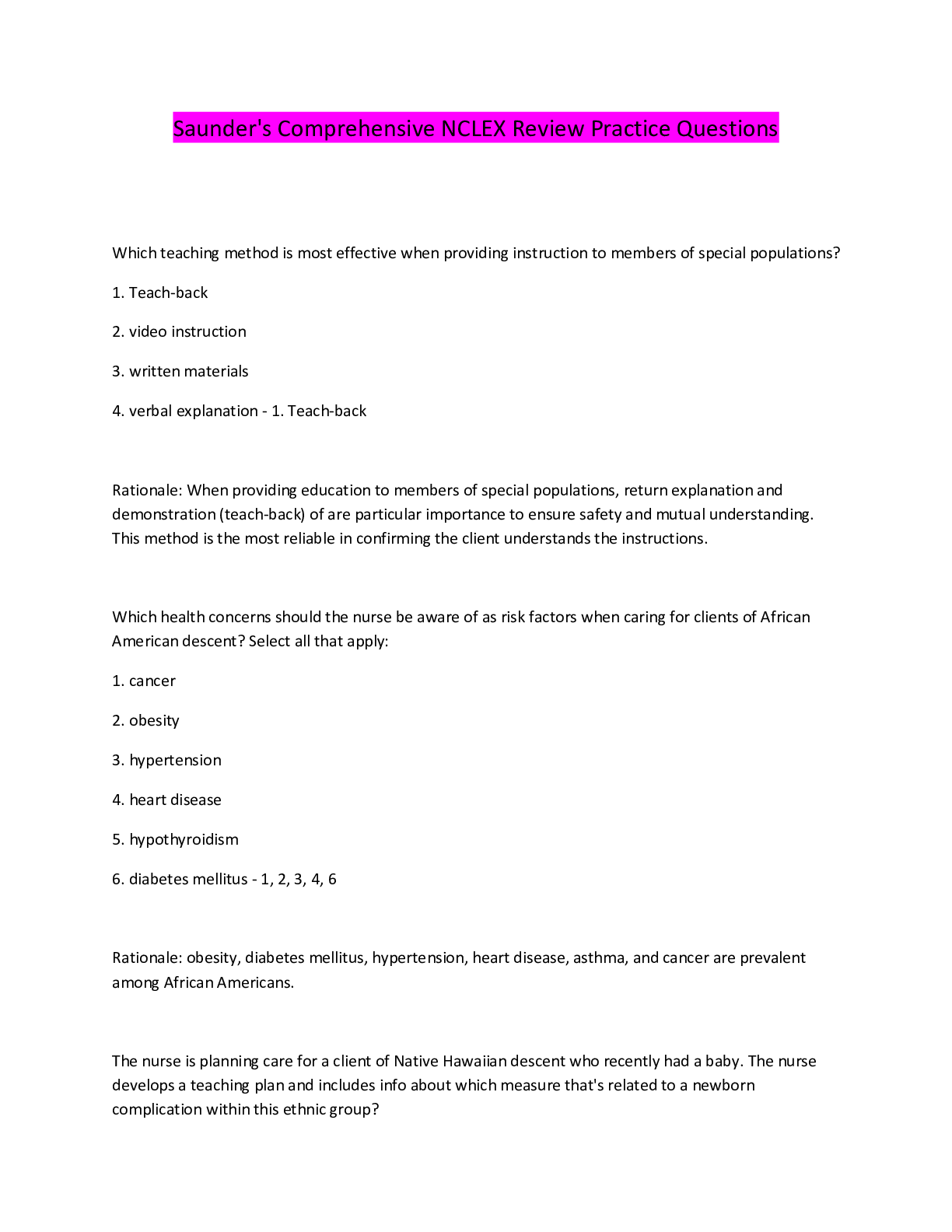
Reviews( 0 )
Document information
Connected school, study & course
About the document
Uploaded On
Jul 24, 2022
Number of pages
43
Written in
Additional information
This document has been written for:
Uploaded
Jul 24, 2022
Downloads
0
Views
31


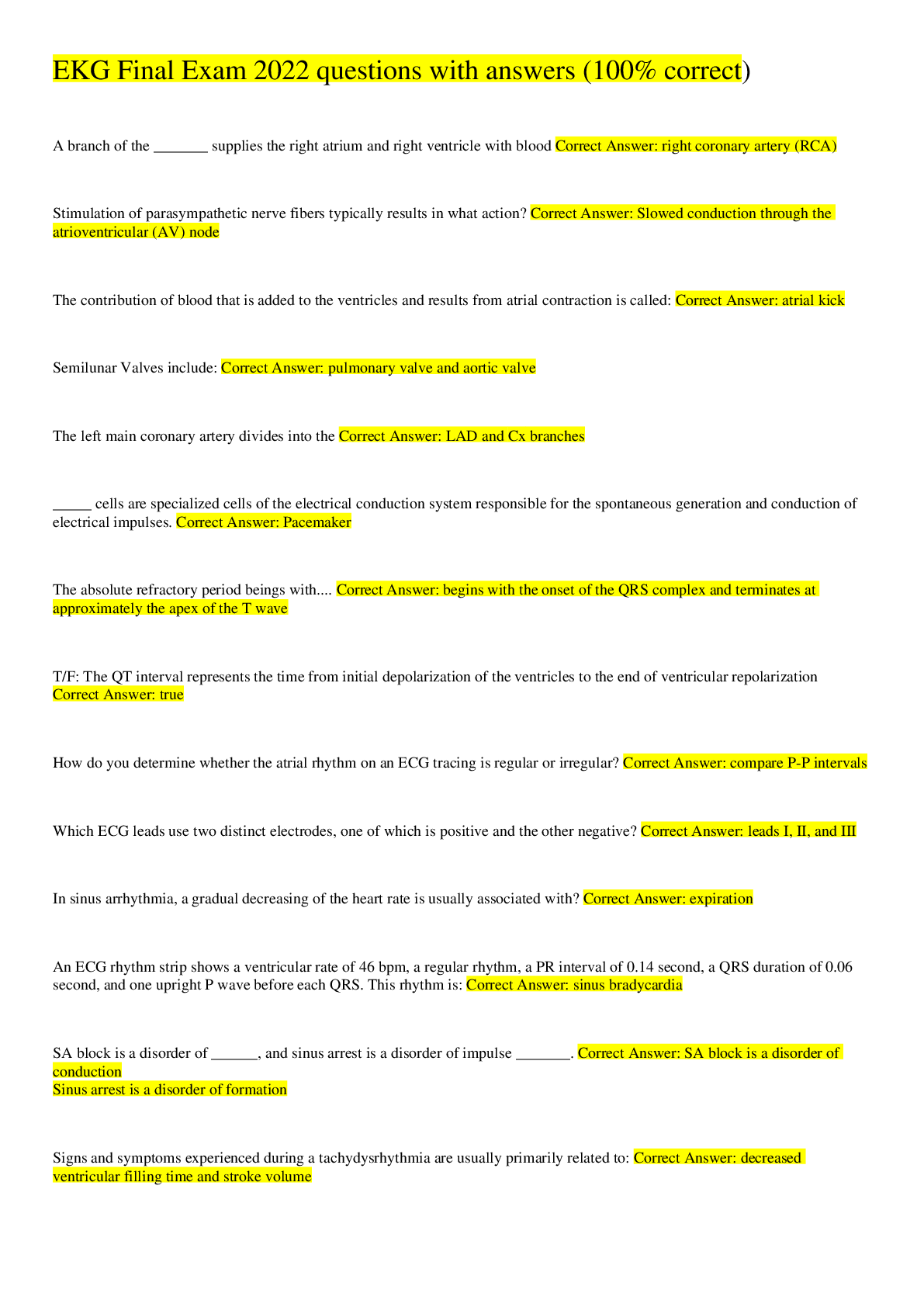
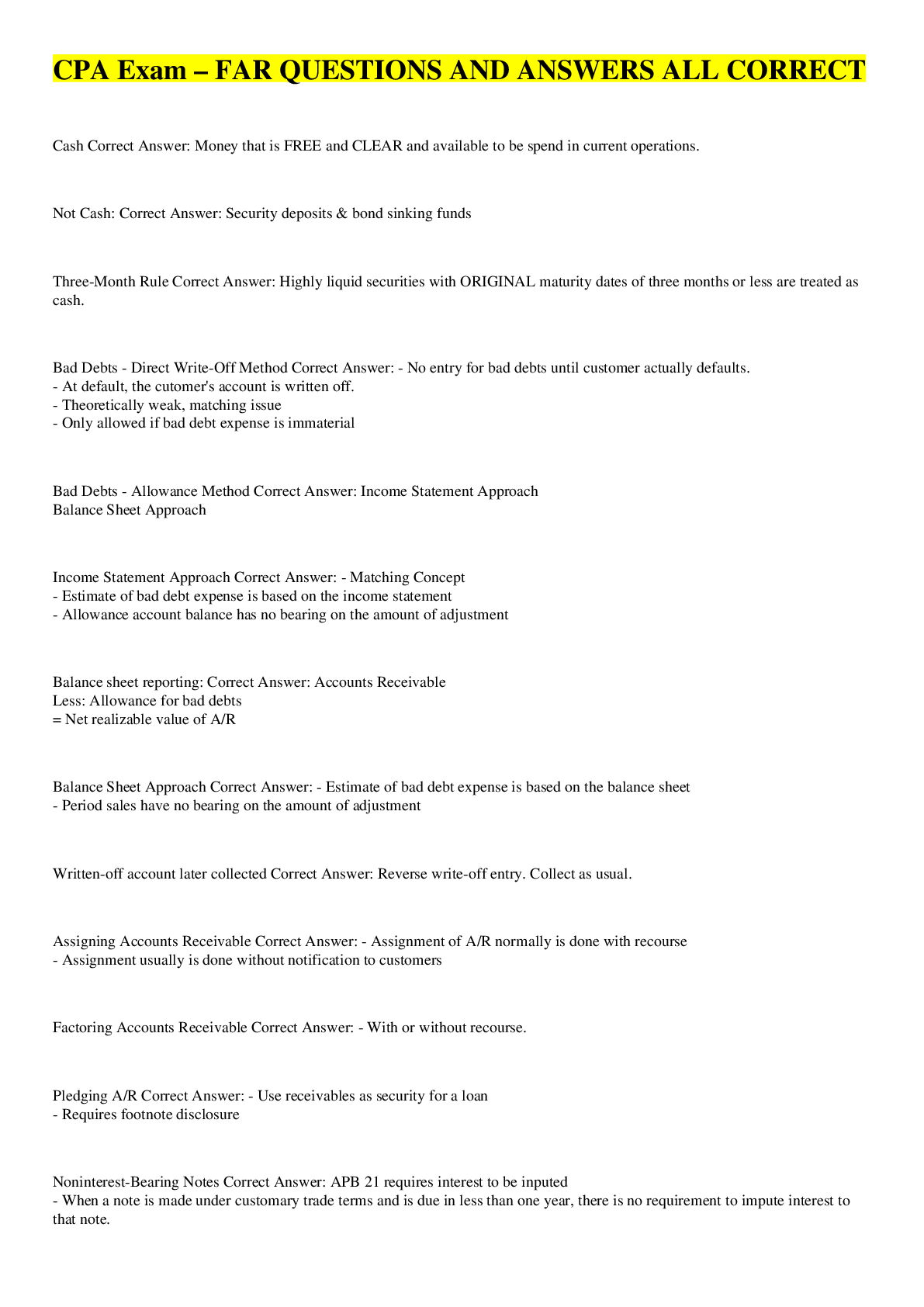
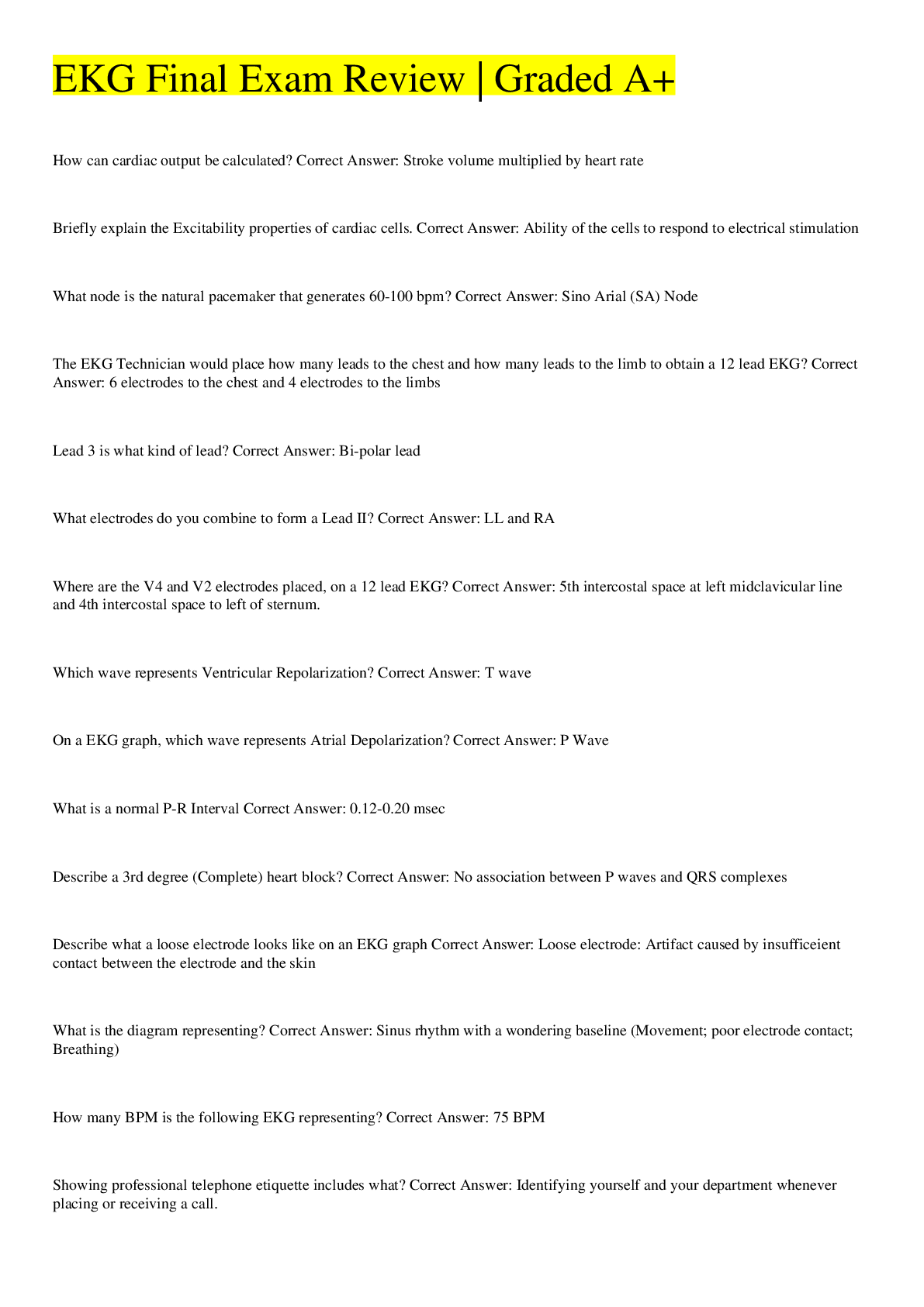
.png)

